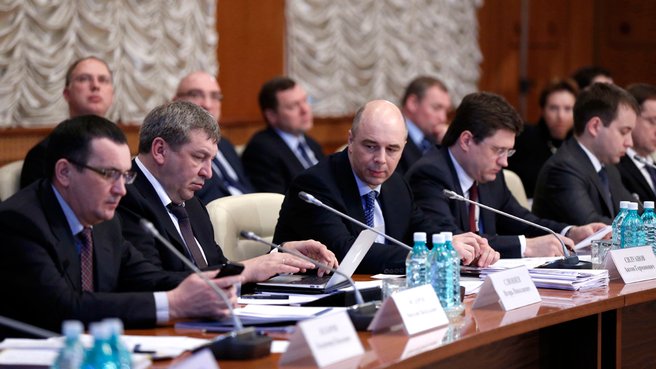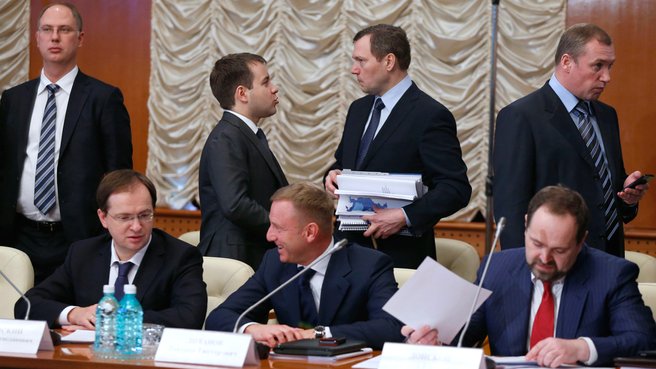Transcript:
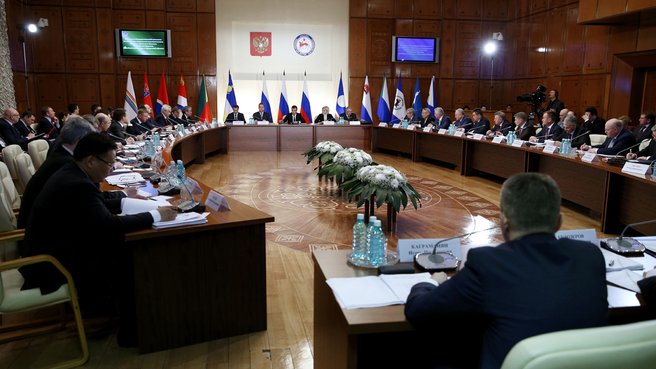
State Commission for the Development of the Russian Far East, the Republic of Buryatia, the Trans-Baikal Territory and the Irkutsk Region
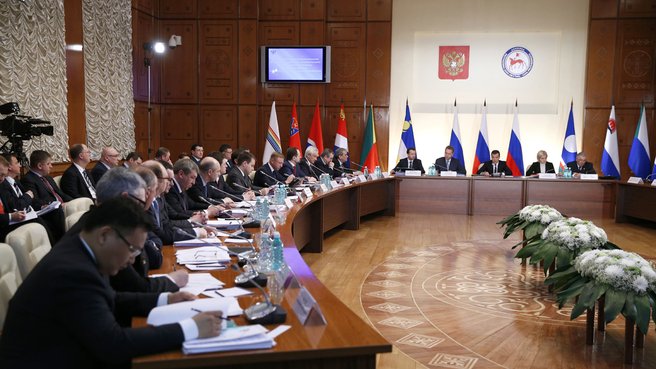
State Commission for the Development of the Russian Far East, the Republic of Buryatia, the Trans-Baikal Territory and the Irkutsk Region

State Commission for the Development of the Russian Far East, the Republic of Buryatia, the Trans-Baikal Territory and the Irkutsk Region
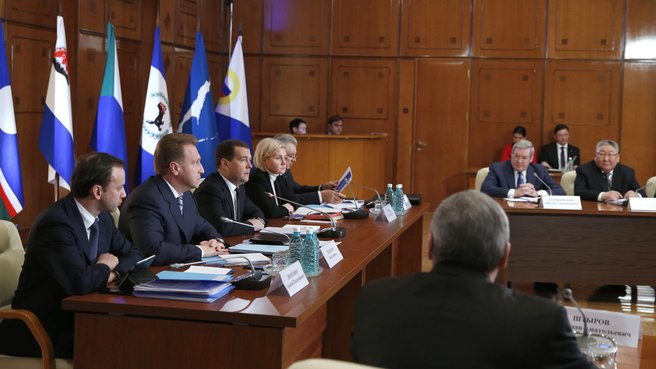
State Commission for the Development of the Russian Far East, the Republic of Buryatia, the Trans-Baikal Territory and the Irkutsk Region
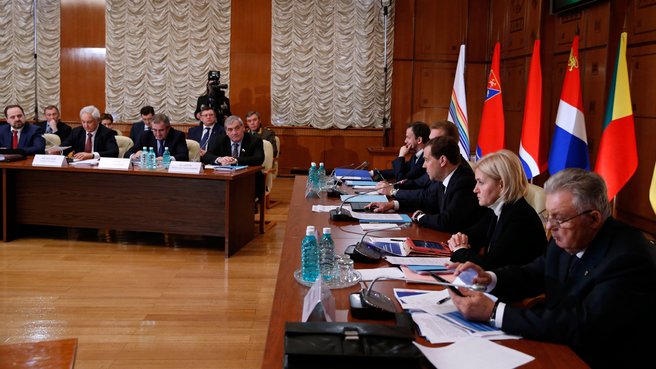
State Commission for the Development of the Russian Far East, the Republic of Buryatia, the Trans-Baikal Territory and the Irkutsk Region
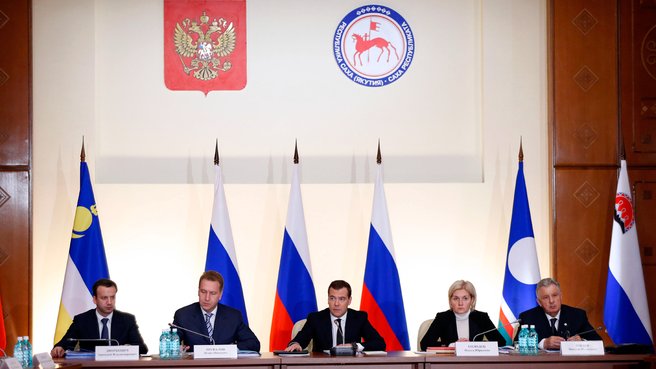
State Commission for the Development of the Russian Far East, the Republic of Buryatia, the Trans-Baikal Territory and the Irkutsk Region
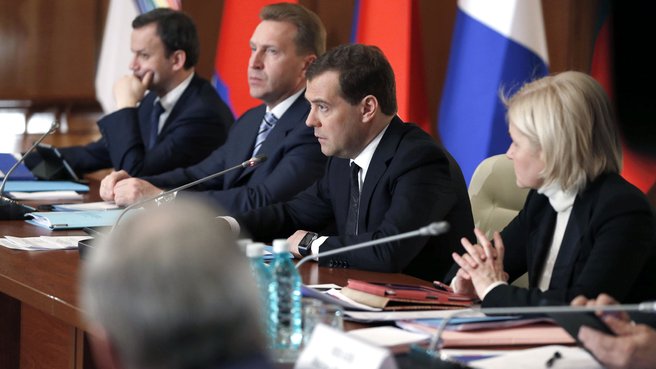
State Commission for the Development of the Russian Far East, the Republic of Buryatia, the Trans-Baikal Territory and the Irkutsk Region
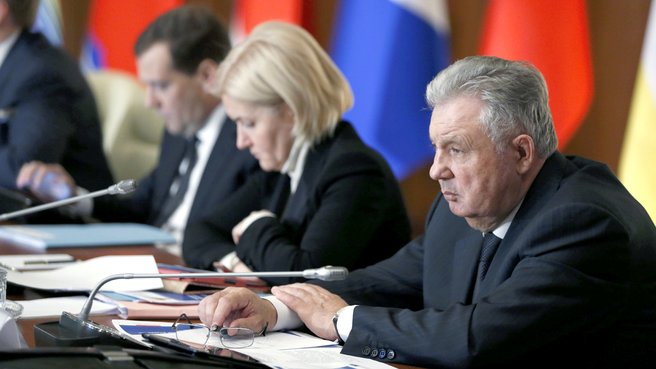
State Commission for the Development of the Russian Far East, the Republic of Buryatia, the Trans-Baikal Territory and the Irkutsk Region
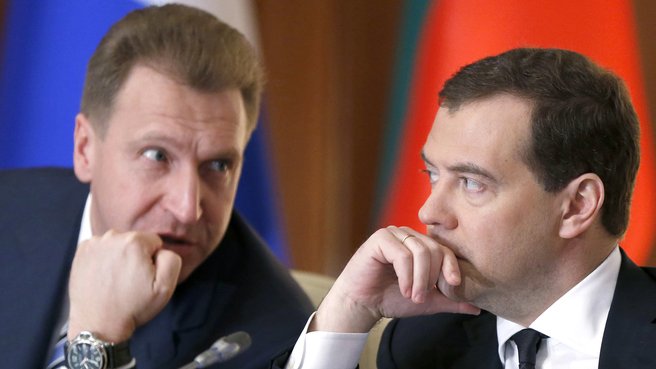
State Commission for the Development of the Russian Far East, the Republic of Buryatia, the Trans-Baikal Territory and the Irkutsk Region
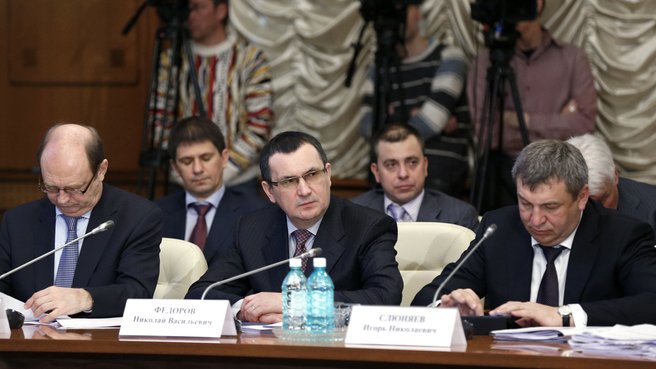
State Commission for the Development of the Russian Far East, the Republic of Buryatia, the Trans-Baikal Territory and the Irkutsk Region
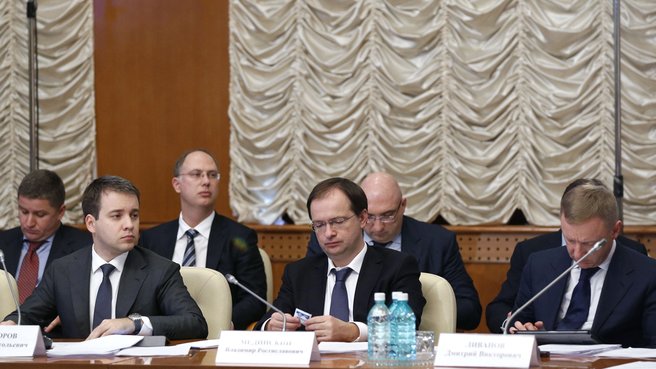
State Commission for the Development of the Russian Far East, the Republic of Buryatia, the Trans-Baikal Territory and the Irkutsk Region
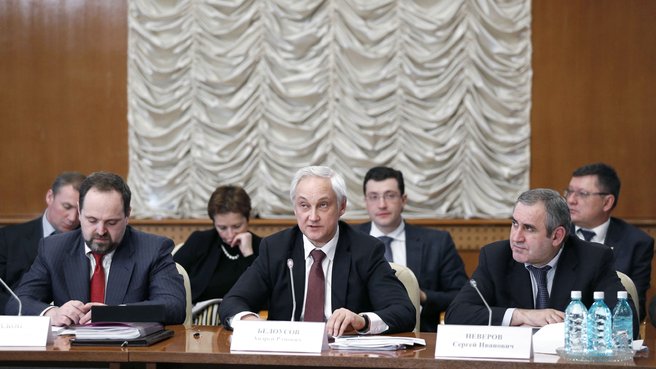
State Commission for the Development of the Russian Far East, the Republic of Buryatia, the Trans-Baikal Territory and the Irkutsk Region
State Commission for the Development of the Russian Far East, the Republic of Buryatia, the Trans-Baikal Territory and the Irkutsk Region
Dmitry Medvedev: Good afternoon, colleagues. Today we are here in Yakutsk to hold a meeting of the State Commission for the Socioeconomic Development of the Russian Far East, the Republic of Buryatia, the Trans-Baikal Territory and the Irkutsk Region. The objectives are ambitious. They are to radically overhaul the energy, transport and social infrastructure of the entire region. We understand how difficult this is to do.
We have been working on the subject nearly all the time. Today I will chair the plenary meeting. A lot of Government officials are involved, which is far from common practice. Why? I want to highlight the importance of the work and the decisions that will be taken.
Now about certain aspects. I will start with the transport infrastructure. We need to change the situation by increasing the capacity of the Baikal-Amur Mainline and the Trans-Siberian Railway, and change the situation in the Far Eastern sea ports. We need to build motorways between Khabarovsk, Vladivostok and Nakhodka.
Additional financing of at least 260 billion roubles will be provided in 2013-2017 to reduce the imbalance in the railway infrastructure on the BAM and Trans-Siberian railways. The Government considers it expedient to add the funds to the charter capital of Russian Railways. We expect the federal financing channelled into the transport infrastructure to create a so-called multiplicative effect. I am referring to the development of a macro-region, the creation of modern jobs and increased tax inflow to the federal and regional coffers.
A planned bridge across the Lena River near Yakutsk has been discussed for years. We have discussed it with Mr Borisov (Yegor Borisov, Head of the Republic of Sakha (Yakutia)) on multiple occasions. The first project was drafted in the 1980s but was never implemented for obvious reasons. I must tell you now that I have signed a directive to organise a tender for a concession agreement to design and build the bridge. We are talking about a full life cycle contract, including operation and maintenance. We agreed on this last year. I expect that everything will be done on schedule and with high quality.
Dmitry Medvedev: We need to change the situation by increasing the capacity of the Baikal-Amur Mainline and the Trans-Siberian Railway, and change the situation in the Far Eastern sea ports.
A private investor – a concessioner – is to design the bridge, using the most advanced technology, and do it as quickly as possible, and with due account for the natural and climatic difficulties. The investments will later be repaid by the federal Government in the previously agreed amount and following a predetermined procedure.
The cost estimate for construction and the initial operation period is 80 billion roubles. The contractors will have to bear in mind that the initial costs of operation will directly depend on the quality of construction and the materials used. This is obvious.
Allow me to bring up another important problem: stable air service between the region and central Russia, and between Far Eastern cities. Old runways need to be modernised and additional ones need to be built; we need to develop short-range aviation and aero-medical services. All aviation facilities need to be repaired and upgraded, including city air terminals. We expect to complete most of these tasks by 2016. But some problems are more pressing and sensitive than others. We have recently discussed the Tiksi problem here in Yakutia. I have discussed this with the regional branch of United Russia. We should do everything as planned. I have spoken about this with the Defence Minister. I have just spoken with a First Deputy Defense Minister. People should be able to travel.
Secondly, improving the investment climate is not the sole responsibility of the federal Government. Regional authorities should get involved, too. This is certainly a necessary condition for economic growth, for large construction projects aimed at building new infrastructure and high tech industrial facilities in the Far East and the Trans-Baikal region.
Last week the Government approved a draft law exempting greenfield projects from the profit tax for five years, and reducing it to 10% for the next five years. It will go to the State Duma soon.
Dmitry Medvedev: One of the key goals of the state programme is to make the Far East a place with decent living conditions, a place for comfortable life and prestigious work.
We are working on other initiatives granting mining privileges in the Far East. I am expecting a report on this.
Russia’s development institutions must also provide support to major investment projects. The Government’s Direct Investment Fund has earmarked 25 billion roubles for this purpose. The Far East and Baikal Regional Development Fund was recapitalised to the tune of 15 billion roubles at the end of last year, although I have not seen much activity there as of late. They had better become active now, otherwise these institutions and their executives’ capabilities will appear questionable. If there are problems with using certain instruments for infrastructure projects, please report on them. We will discuss them and amend the legislation if needed.
The third problem is the energy system. The Far East needs a full range of energy resources, and local consumers should have easy access to these resources. Investors should be relieved of this problem. There is a pilot project to build four power stations in the Far East. The project includes comprehensive banking services, such as cost and process audits. It would be good to invite respected foreign companies to perform audits for all major construction projects. The construction costs should be transparent and based on modern technological solutions.
One of the key goals of the state programme is to make the Far East a place with decent living conditions, a place for comfortable life and prestigious work. This is not an easy task to accomplish, but it is attainable nonetheless. It involves modern, high quality and affordable healthcare services, education and housing.
I would like to cite a few priority construction projects. This does not mean, however, that other projects are low-priority. High tech medical centres, including children’s and prenatal establishments, will be built in Vladivostok and Magadan during this year and the next.
A cultural modern art centre and a new facility at the Children’s Okean (Ocean) Centre in Vladivostok will be opened. We have visited it fairly recently. We are studying the issue of establishing a modern centre of nuclear medicine at the Far Eastern Federal University. A rehabilitation centre for people who find themselves in extreme situations will open in Khabarovsk next year. This year, students of the Ammosov Northeastern Federal University will receive a new dormitory for almost 1,000 people in Yakutsk. And we stipulate many of these growth points. I would like to stress once again that everything I have just mentioned does not reflect the entire potential and the entire list of the relevant facilities.
I would now like to hear reports listing various facilities that should be opened in various regions, from the relevant ministers. And please tell me what is being done to attract private investment, to take out loans and to activate the mechanisms of public-private partnership.
Every rouble currently being invested in the Russian Far East makes it possible to attract up to five roubles’ worth of private capital. And extra-budgetary funding must become the main driving force behind the rapid development of the relevant macro-region. I would like to emphasise that, as a result of our long and difficult consultations and debates, which are still ongoing in some areas, we have accumulated unprecedented allocations for the state programme. This sum total is truly tremendous. But, no matter how huge this sum is, we would fail to accomplish any key objective without large-scale investment in the Russian Far East. Incantations are useless here. I also suggest that we use income from managing National Prosperity Fund assets as another source of allocations. Pension Fund assets could also be loaned for implementing investment projects.
Today, I have met with Government members after arriving here in the morning. We have discussed the situation in the Far East, the entire global economic situation and the economic situation in Russia, because some factors tend to hamper development. Of course, this is hardly positive. We must understand what needs to be done in order to ensure Russia’s economic development under our own scenario.
Colleagues, let’s start discussing various issues of the development of the Russian Far East and adjacent regions. The Minister of Economic Development will be the first to speak. Mr Belousov (Addressing Andrei Belousov), you have the floor.
Andrei Belousov: Thank you. Mr Medvedev, colleagues, the handouts contain updated slides with updated statistics. This is the version I will be using.
First of all, I would like very briefly to cover the general logic of the development strategy for the Russian Far East and the Trans-Baikal Territory, which is the foundation of the federal targeted programme. This logic hinges on the maximum effective use of the following natural advantages of the Far Eastern region. First, the region provides direct access to the dynamically developing Asia Pacific markets, primarily those of China and South East Asia. I would like to say that these markets have a total volume of about $20 trillion. Chinese markets account for about 50% of the grand total. What’s also important is that, despite the 2008-2009 crisis, these markets have expanded by about 50% in the past five years.
Second, the region has an immensely rich resource potential, including coal and hydrocarbon deposits, hydropower resources, iron ore, non-ferrous metals and rare-earth metals deposits, timber resources, etc. And, third, the region has a diverse climate, making it possible to accomplish any objective in the context of industrial and agricultural development. At the same time, these advantages are hampered by certain restrictions, including low population density, which is aggravated by a primitive social sector and a lack of the required infrastructure. Consequently, the domestic market remains underdeveloped. The macro-region has a lop-sided economy that relies heavily on the commodity sector. I would like to say that minerals production accounts for about 33% of the GDP of Russian regions that are part of this macro-region. On the whole, this proportion is 9.3% nationwide. This balance of advantages and restrictions determines priorities of the long-term development strategy for the Russian Far East and the Trans-Baikal Territory. We must focus on the following four high-priority aspects in order to tap the available potential to the maximum extent possible and to ensure the rapid development of the Far Eastern macro-region. First, we must develop the transport and energy infrastructure more rapidly. Second, we must create conditions for implementing about 15-20 major comprehensive investment projects with long recoupment periods, for a start. In the future, new development centres will be established on the basis of these projects. Third, we must create a competitive market in the Russian Far East and the Trans-Baikal Territory. Fourth, we must develop the regional human capital and human potential by creating comfortable living conditions and by developing modern educational and research centres.
Of the four high-priority objectives that have been mentioned here, the development of the infrastructure is the main pre-condition necessary for sustained regional development. Otherwise it will be impossible to accomplish the other three objectives. This is why we need a comprehensive instrument with clear target indicators, a list of tasks and deadlines, chief executors, project managers and sources of funding. The federal targeted programme, the new version of which stipulates the relevant allocations for accomplishing assigned objectives in 2013-2017, is an optimal instrument.
Under this programme, we plan to implement about five system-wide projects designed to eliminate infrastructure constraints and create infrastructure capacity primarily in the transport complex and the power industry.
The first project is intended to overhaul and increase the carrying capacity of the BAM and the Trans-Siberian Railway. This is the key project within the planned programme. Its implementation will make it possible to unlock practically all the mining projects in the Russian Far East and the Baikal region. We plan to increase freight traffic to 38 million tonnes a year by 2015 and 54 million tonnes by 2020 as compared with 16 million tonnes today. This means that the carrying capacity will practically double in three years’ time. But the BAM will still have stretches with a deficit of carrying capacity, which will amount to 4,000 km by 2015 and 4,300 km by 2020. Thus, despite this considerable increase in freight traffic, we will still have a deficit of carrying capacity on our hands.
Funding for this project will total 1 trillion roubles between 2013 and 2017, or, to be more precise, 980 billion roubles, of which 260 billion roubles will come from the federal budget.
The second project is aimed at promoting regional air carriage. We want to improve the transport accessibility of the Far Eastern market and increase the population’s mobility, which is of crucial importance for the macro-region’s economic development. Under this project, we’ll have to rebuild two major airports in Ulan-Ude and Petropavlovsk-Kamchatsky and modernise 61 airports in Yakutia, Buryatia, the Kamchatka Territory, the Chukotka Autonomous Area, the Amur and Irkutsk regions, as well as the Khabarovsk, Primorye and Trans-Baikal territories. A total of 101 billion roubles will be allocated for these purposes from the federal budget.
The third project involves building a network of motor roads. The aim is to increase the accessibility of port infrastructure and to link populated areas in the Far East with the federal motor road network. We plan to modernise the Vladivostok-Nakhodka, Khabarovsk-Vladivostok and Bratsk-Mirny motor roads and the approach roads from populated areas in the Amur Region and the Trans-Baikal Territory to the Chita-Khabarovsk motorway. We will need 60 billion roubles from the federal budget for these projects.
The fourth project seeks to develop port infrastructure. The aim is to invigorate maritime traffic and freight carriage in the region and internationally. We plan to modernise federally-owned facilities in the ports of Magadan and Pevek and to build a new specialised port on the Far Eastern coast to enable small and medium-sized coal mining companies to access port infrastructure. A discussion is in progress on where to build the port. We also plan to continue developing the Vanino-Sovetskaya Gavan industrial and transport cluster in the Khabarovsk Territory. To address this task, the Government has established a special port economic zone. To finance the port infrastructure project, 25 billion roubles in federal allocations will be needed.
And, finally, the fifth project deals with the development of the power industry. Its aim is to reduce generating costs and to create power supply capacity for major investment projects in the region and for transport and social infrastructure. I’m referring primarily to the Central Heating and Power Plant in Sovetskaya Gavan, the Regional Power Station-2 on Sakhalin Island, the Regional Power Station-2 in Yakutia, and the Central Heating and Power Plant in Blagoveshchensk. These construction projects will be financed from the budget of 50 billion roubles allocated to the RusHydro Company under a presidential order issued on November 22, 2012.
Electric grid development projects will be implemented under an investment programme drawn up by the Federal Grid Company, which cover about 10 facilities worth a total of 58 billion roubles.
Where the federal targeted programme itself is concerned, it envisions the construction and modernisation of 12 local generation facilities in the Sakhalin Region, the Khabarovsk Territory, the Republic of Sakha (Yakutia), the Chukotka Autonomous Area, and the Trans-Baikal Territory. We will need 33.2 billion roubles in federal budget allocations for these purposes. But there are some other facilities (about 13 billion roubles) which we have been working on jointly with the Ministry of Energy. These facilities will replace the capacities about to be decommissioned at the Bilibino nuclear power plant. I mean that the overall sum is likely to grow. Thus we will need a total of 526 billion roubles in federal budget allocations for these five projects in the period from 2013 to 2017, or slightly over 100 billion roubles per year. Of these funds, 47 billion roubles will be allocated this year to complete the facilities under the federal targeted programme for the development of the Far East and the Baikal Region. As a result, we will need an additional 476 billion roubles in funding for the period in question, not including the 13 billion roubles for energy facilities, which I mentioned earlier.
As Mr Medvedev mentioned in his opening remarks, we are planning to use the proceeds that the Government earned from managing the resources of the National Wealth Fund. But I should note, Mr Medvedev, that this amount is not sufficient. These funds amount to about 70 to 80 billion roubles annually, whereas to implement the federal targeted programme, including all of the projects that I mentioned, we need about 100 billion roubles. Therefore, we will need to find an additional 20 to 30 billion roubles.
I would also like to point out that as of today the draft federal programme has been almost completed, but we still need to slightly adjust it to reflect the concentration of resources on the five priority projects in question. To implement the programme as early as this year, it has to be approved by the Government no later than July of this year. Toward this end, we propose instructing the Ministry for the Development of the Far East, which is the client and coordinator of this programme, together with the Ministry of Economic Development, the Ministry of Finance, and other relevant federal agencies, to finalise the draft programme and submit it to the Government no later than July 1 this year. Thank you for your attention.
Dmitry Medvedev: Thank you Mr Belousov.
I would also like to hear from the Minister for the Development of the Far East. Mr Ishayev, go ahead, please.
Viktor Ishayev: Thank you Mr Medvedev. Indeed, the Ministry is the client and coordinator of this programme. It was prepared and agreed upon with everyone, but, of course, we will need to adjust it, taking into account the changes in the goals and objectives that have been made. I believe this is logical and justified.
I would like to remind everyone so that nobody is confused about the programmes. The state programme has been approved, it consists of two federal targeted programmes and 12 sub-programmes. The federal targeted programme The Far East and the Baikal Region is the key element of the state programme, and we attach great importance to it.
I would like to emphasise, Mr Medvedev, that the development of the Far East is extremely important for the region, but it is also extremely important for the development of the Russian economy in general. As we have demonstrated, the funds invested in the Far East will pay off. Even if under the larger programme, which assumes spending 10.6 trillion roubles, we spend 3.8 trillion roubles by 2025, we will receive over 5 trillion roubles in revenue. The revenue estimates range from between 5 to 9 trillion, but we take 5 trillion as the most realistic scenario.
We are convinced that Russia’s GDP will grow by 0.3% annually, and will increase by 20.6 trillion roubles by 2025. We believe that by supporting this large sub-region, we are providing a strong impetus for the development of Russia’s economy in the Asia-Pacific region, which makes this task all the more important. The projects that we discussed today are well balanced. They will provide a multiplier effect and will serve as engines of growth for the economy of the Far East and the Russian economy in general.
I would like to point out that under the proposals that Mr Belousov mentioned, major infrastructure projects will be removed from the revised programme. We have previously noted the fact that some ministries and agencies have tried to avoid including these programmes in sub-programmes for their relevant sectors.
I believe this is the wrong approach, and we will have to review these sectoral sub-programmes again to ensure that we are not left without a social sphere. The proposed volumes are minimal. The sources have been discussed here, and we understand that funding will not come from a single source. It could include resources from privatisation, from various funds, as well as loans and budget sources. Therefore, we will have to work in a very consolidated and effective manner in that direction.
Viktor Ishayev: If this programme is implemented, we estimate that the average salary in the Far East will exceed the average salary in Russia by 22%.
I believe that if during this period (five years), the proposed 526 billion roubles are invested and have the multiplier that you mentioned, it would mean attracting money at the ratio of one to five. But there is another multiplier, when the secondary and the tertiary sectors are involved and when people are investing money and the domestic market is starting to grow and internal demand is increasing. In economics this is known as a 1.35 ratio, which creates an additional growth stimulus.
We also expect that these programmes will allow us to create an additional 200,000 jobs at the first stage of their implementation. This is also a very positive and significant factor, which will provide an additional revenue source for the regional budgets.
I would also like to draw your attention to the following. These projects that we are discussing – take energy, for example: there are four energy projects with a total budget of 50 billion roubles. The executive order has been signed, but to date not a kopeck has been spent. Why? The reason is that there is no project documentation.
Quite often when we say that we are ready to take the funds, we are told we can certainly have them, but cannot spend them, as there is no project documentation and expert assessment.
I believe that this year (and this has already been discussed) we should focus our efforts on drafting project documentation. And then we will gradually be able to spend these funds – otherwise we are simply not ready to do that, whether it concerns the transport infrastructure, the energy infrastructure (I am not blaming anyone here, just saying things the way they really are), or many other sectors. We will have to make a serious effort toward this end, to somehow resolve these issues.
By the way, if this programme is implemented, we estimate that the average salary in the Far East will exceed the average salary in Russia by 22%. Today this figure is just 12%. In other words we support this programme, and we want it to remain as it is.. We understand that we will have to continue working intensively, but this is normal and we are ready to address these issues. Thank you.
Dmitry Medvedev: Thank you. Now let’s have the Ministry of Finance comment on this issue. Mr Siluanov, please.
Anton Siluanov: Thank you Mr Medvedev. Colleagues, indeed, the proposed funding is 526 billion roubles, which is a very ambitious task: it amounts to about 100 billion roubles per year. Let me remind you that according to our preliminary estimates we had approximately 40 billion roubles earmarked per year for the next five years. Nevertheless, it is a priority. I think the tasks and targets set by the programme should be implemented.
From which sources? First of all, Mr. Belousov listed assets from the National Wealth Fund, the investment from which in 2012 yielded around 80 billion roubles. I’d like to say that basically, in accordance with the 2010 federal law, NWF investment revenues are already accounted for in the budget’s income base up to 2016. That’s why in order to find additional funds we have to, firstly, look into the possibilities in the state programmes currently in effect in terms of redistributing their funds, and we do have such funds (on the whole this means primarily the development of the transport system). We should use the opportunities offered by our development institutions which were also given budget money last year, and I think we shall keep on filling them this year too. This is primarily the Russian Direct Investment Fund, and also the Far East Development Fund, which also has significant resources that we should start using as soon as possible to implement the programme.
I believe we should first of all make use of the state-private partnership mechanisms which you, Mr Medvedev, have already mentioned. Indeed, there is a whole range of such projects like ports, airports, possibly, paid infrastructure sections. It is precisely these projects that can be launched and implemented in the Far East as basic, pilot projects one could even say, to be implemented in the whole of Russia going forward.
There is one more point I’d like to talk about. The main need is certainly to expand and reconstruct the Baikal-Amur Railway and the Tran-Siberian Railway. In our opinion we have to use all possible resources, namely, Russian Railways funds which can attract loans by using assets and accumulated pension funds, and we are ready to invest the assets of the National Wealth Fund. We can and should also involve tariff resources, that is by including an investment component into tariffs that would provide funds for implementing projects, as well as tariff calculations such as “Inflation Plus.” "Inflation Plus" is what will helps us find funds, long-term funds for the implementation of investment projects. That is why a whole range of measures – additional budget allocations, the assets of large corporations and development institutions, the use of state-private partnerships – will enable us overcome the challenges we are facing concerning the funding of this programme. Mr Medvedev, we will draft the budget for 2014-16, we will search for resources for the implementation of the programme, but let me reiterate, we will also have to prioritise the size of budget funds earmarked for the coming three years. Because without that we will not be able to assess our needs for funding the programmes. Thank you.
Dmitry Medvedev: Priorities should always be set, that much is clear. One of the most important priorities for the state is the Far East. I would like the Finance Ministry to bear this in mind.
Minister of Energy Alexander Novak, over to you please.
Alexander Novak: Thank you. Mr Medvedev, colleagues, the Ministry of Energy has been participating in the targeted programme since 2008. I would like to start by saying that throughout the implementation of the current federal targeted programme we have been financing energy sector facilities to the tune of 71.317 billion roubles from the federal budget. So far this has enabled us to implement 19 large infrastructure projects in the past four years. Some of the projects are still ongoing, and following instructions from Mr Shuvalov we are going to complete the construction of all the facilities previously launched in the Far Eastern Federal District.
I would also like to outline investment projects for the planned period of 2014-16. We have identified a list of specific priority investment projects for the Far East and the Baikal area. We assess the total amount of funds from different sources at around 700 billion roubles, with 46.2 billion roubles coming from the federal budget, that is roughly 6.5 percent of the total amount to be directed into the energy sector and under 5 percent of the declared funding of the Federal targeted programme earmarked for the five-year period Mr Belousov spoke about in his report. The investment project will be aimed at …There are several major strands. They are the connection between the power systems of Eastern Siberia and the Far East, including the electrification of the Baikal-Amur and Tran-Siberian Railways, the accelerated implementation of the eastern natural gas programme, connecting isolated power systems to the unified energy system of Russia, satisfying demand and eliminating risks of electric and thermal power shortages in the Baikal area and in the Far East, developing the power industry based on sustainable energy sources and as a result, decreasing the level of budget subsidies needed to cover the difference between economically reasonable tariffs and those used for consumers. We have used the following approach for identifying funding sources for the priority investment projects, of which there are four. The first one is the development of core power transmission lines. We consider it reasonable to implement this as part of the FSK EES company’s programme without federal budget funds, by using long-term loans from Vnesheconombank which can be offered at discount rates from accumulated pension funds. Fifty-eight billion roubles are needed for the period. That means 10 large core transmission lines.
Secondly, jointly with the Far East and Baikal Area Development Foundation, we have worked out a preliminary list of investment projects to set up supply centres for new industrial consumers. There are 20 projects totaling 77 billion roubles. Special purpose vehicles (SPV) will set up for them. The projects will be financed from the Foundation based on a 13-15 year payback period at the level of inflation plus one percent added to electric power tariffs. Most of these are grids that reach out to new consumers, Here are some examples: the Udokan mining processing company, Polyus Zoloto, the Natalkinsky mining processing company, the Komsomolsk refinery, the Inaglinsky coal complex and others. On the one hand, the second suggested mechanism will mean that the debt burden on consumers and the Federal Grid Company will not increase. On the other hand, it will make sure that power lines are not constructed without having prospective customer as this kind of situation often leads to price rises for all consumer groups in the region.
The third approach and the third direction concerns power facilities aimed at exporting electricity. These projects should be funded via external sources. Here we are looking into the possibility of involving the Russian Direct Investment Fund.
Fourthly, as far as the federal treasury goes, we believe it could serve as the source of funding for several groups of projects. We could use money from the federal purse to complete projects that had been launched earlier under the current federal targeted programme – projects that are impossible to implement without federal support. A second group of projects that may benefit are ones based on renewable sources of energy. Thirdly, [federal finances could be used for] investing in regional property with some social function, because such property cannot possibly be maintained without federal budget allocations. I’ve cited the figure 46 billion roubles, but this amount doesn’t include the 50 billion earmarked for investment in four projects being implemented by RusHydro.
Let me now respond to Viktor Ishayev’s question on drafting and estimating blueprints [for the hydro-electric power station Yakutsk II]. Today we’re on location, in Yakutsk. The project’s drafting and estimating blueprints have already been prepared and submitted to Glavgosexpertiza regulators. The funds were not disbursed until last December. But three months is not a long enough time for a project’s drafting and estimating blueprints to be prepared. All the other projects have also been commissioned, and are currently in progress.These projects could be launched as soon as they pass through state expert examination. We’re keeping the situation under control, in cooperation with the Ministry of Economic Development and Sberbank. As an example, let me cite several projects that have been included in the federal targeted programme. In Chukotka, as was said earlier, the Bilibinskaya HPP and the Chaunskaya TPP are being put out of service, and will have to be replaced with new facilities. We’re planning the construction at this site of centres with combined electrical/thermal power generation. For the Magadan region’s grid to operate to capacity, the construction of the Orotukan-Palatka-Tsentralnaya electricity transmission lines has to be completed.
The Kolymskaya and the Ust-Strednekanskaya hydro power plants will make the power supply more reliable in the southern Magadan region.
In the Khabarovsk Territory, a high-voltage substation in the Vanino-Sovetskogavansky hub will be built. A high-voltage substation is to be built to supply power to communities in the Ulchsky district. In the Republic of Sakha (Yakutia), a project to build a mainstream gas pipeline, Kysyl-Syr, will enhance the reliability of gas supplies to consumers in the republic’s central areas.
A separate area of activity is the development of renewable energy sources and the construction of electricity-generating wind turbines and solar stations, which could become a substitute for costly diesel generation.
In the Sakhalin Region, projects on the construction and renovation of electricity grids will be aimed at enhancing the reliability of power supplies and removing technology linkup constraints for new customers. We also have a renovation project for the thermal station in the town of Pervomaisky and projects for the construction and renovation of grids in the Irkutsk Region.
Mr Medvedev, I’d like to point out that, as estimated in the federal target programme’s first draft, the federal funding needs totalled 146 billion roubles. Later on, the figure was brought down to 98 billion. Now, proceeding from our budgetary potential and the reduction of the programme’s total estimates to 500 billion, we’ve slashed the federal funding rate further, to 46 billion. This is about 10% of the total. The rest will be raised using mechanisms I mentioned earlier. The total power supply needs come to about 700 billion roubles, in our estimates. Thank you.
Dmitry Medvedev: Good, continue searching [for non-budgetary sources of finance]. Mr Belozyorov, Deputy Minister of Transport.
Oleg Belozyorov: Mr Prime Minister, Ladies and Gentlemen. The development of Russia’s Far East and the Baikal Region, as well as of the country at large, depends on the efficient operation of the transport system. The region’s main feature is its vast size. The proportion of transport in the Gross Regional Product is 11%, compared to the national average of 7%. In the Primorye and Khabarovsk territories, and in the Amur Region, this share is above 14%, while in the Baikal Region it stands at around 20%. At a session held 9 months ago, the State Commission examined in detail the current state and prospects for the further development of the transport network of Russia’s Far East and the Baikal Region. Decisions made based on the session’s results were reflected in state programme The Socioeconomic Development of the Russian Far East and the Baikal Region, and for the advancement of their transportation networks. The latter provides for 840 billion roubles to finance investment projects in the area from 2013 to 2020, including 550 billion from the federal treasury, 283 billion from extra-budgetary sources and 5.5 billion from regional coffers. The measures set forth in the programmes to advance the area’s transportation network are mutually complementary and inseparable from one another.
As has been said earlier, rail transport is a key priority. The implementation of plans to develop mineral deposits in the Far Eastern and Siberian federal districts and the construction of port export capacities in the Vanino transport hub and in ports of the Primorye Territory, will substantially increase the traffic load primarily on the BAM and the Trans-Siberian railways. On the approaches to BAM’s Komsomolsk railway hub, the freight load is expected by 2015 to grow by 3.3 times on today’s level and by nearly 4.5 times by 2020. And total cargo railway traffic on the approaches to Vanino will surpass the 41 million tonne mark by 2015 and almost 60 million by 2020.
The Primorye Territory should be mentioned separately, because here cargo traffic may reach 91 million by 2015 and over 100 million by 2020. To cope with the growing load, we need a major overhaul of the rail infrastructure. Bearing in mind that the budget financing capacities are quite limited, we’ve analyzed this project together with Russian Railways (RZhD) and have made estimates as to the required investment. To raise the traffic capacity by 25 million tonnes, we’ll need an estimated 562 billion roubles in investment, with 302 billion to be provided by RZhD. We’ll need federal budget support to cover the remaining 260 billion.
The implementation of the project to develop the Trans-Siberian Railway and the Baikal-Amur Mainline will give a boost to the investment flow into related industries. For instance, about 100 billion roubles will be set aside from non-budgetary sources for the development of the port infrastructure alone by 2020. Of Russia's 64 sea ports, 28 operate in the Far East. Over 70% of cargo turnover is handled by the main sea ports, located in the Khabarovsk and Primorye territories: the Vostochny, Nakhodka, Vladivostok, Vanino and De-Kastri ports. The first four ports are among the 10 largest ports in the country and are the main components of railway-sea transport hubs. The Vanino – Kholmsk ferry provides a stable connection for linking Sakhalin Island with the mainland, and over 90% cargo shipped in these ports is delivered by train.
The Transport System state programme includes developing the capacities of the ports of Vanino, Nakhodka, Vostochny, Kozmino and Posyet, constructing a coal terminal in Izylmentyeva Bay and a new port in Nabil Bay. The development of the ports is mainly being conducted with the help of private investors. Government funding stands at 20%, and is directed at state-owned facilities: the formation of water areas, the construction and modernisation of mooring berths and the improvement of navigation system safety.
The Socioeconomic Development of the Russian Far East and the Baikal Region state programme includes the development of social infrastructure at ports, and the building of ferries for the Vanino-Kholmsk ferry crossing. In addition, Mr Belousov said in his report that a new port with a capacity of 20 million tonnes of coal should be built to ease access to the port infrastructure that belongs to small and medium-sized coal-producing companies. The port is supposed to be built in Sukhodol Bay in the Primorye Territory. The estimated cost of the construction of the terminal is about 18 billion roubles, while the cost of the federal infrastructure is about 3 billion. On Thursday, the Ministry of Transport held a joint meeting with Russian Railways and the companies who operate the sea ports (Mechel, Siberian Coal Energy Company, Tuva Company and others), during which all companies confirmed their plans to develop the port infrastructure and the presence of cargo bases.
As for civil aviation, The Transport System Development state programme includes, besides the renovation of large airports such as Yakutsk, Magadan, Yuzhno-Sakhalinsk, Irkutsk and Khabarovsk, increasing public accessibility of air transport, both regional and local. The complex of measures was divided into three areas: subsidising air travel, subsidising aircraft leasing (including regional and local) and supporting federal companies established at regional and local airports. Meanwhile, due to the chronic underfunding of airports in recent years, the federal companies based at them are in a very poor state. To that end, the Socioeconomic Development of the Russian Far East and Baikal Region state programme has set the development of these companies as a top priority. The implementation of the programme will not only allow regional and local air passenger traffic to double compared to 2012, but will also ensure the implementation of presidential executive orders to improve transport accessibility in remote regions.
Regarding road infrastructure, the programme stipulates the construction and renovation of the network of federal motorways, Lena, Kolyma, Vilyi, Baikal, Amur and Ussuri. But the development of the federal motorways must be supported by the development of regional roads. The programme includes the construction and renovation of the most important regional routes, which will have a positive effect on the development of the region overall. They include the routes Vladivostok – Nakhodka, Lidoga – Vanino, Yuzhno-Sakhalinsk - Okha, Petropavlovsk-Kamchatsky – Klyuchi – Ust-Kamchatsk, Palatka – Kulu in the Magadan Region, Birobidzhan – Leninskoye, and Kolyma – Anadyr.
The Ministry of Transport and other bodies concerned are actively participating in reviewing the programmes and its priorities. We have to revise the transport development programme, so that it incorporates both our transport development priorities and our stated objectives to develop the Far East. As for transport development priorities, we ask you to support them.
Thank you.
Dmitry Medvedev: Thank you.
Viktor Ishayev: Let me add a few words.
Dmitry Medvedev: Go ahead, Mr Ishayev.
Viktor Ishayev: A ferry service between Vanino and Kholmsk that was expected to resolve all problems has become outdated. New ferries will not provide a proper solution, as the service is suspended 30% of the time due to poor weather. I insist on the construction of a bridge between the mainland and Sakhalin Island.
Mr Belousov was absolutely right when he said that the existing port capacity does not meet our needs, while Sakhalin has ice-free ports. So, building a bridge could provide solutions to two problems. I would like the proposal to consider the construction of a bridge to be mentioned in the minutes.
The next issue concerns the Trans-Korean Railway. If we ignore this issue, they will carry goods from the east in a westerly direction bypassing Russia. If we do not address these issues, we will not be engaged in the transportation process. If we fail to take these goods at, say, the port of Busan and carry them to Europe, we will lose a great deal.
I want these two issues to be subject to further consideration.
Dmitry Medvedev: Thank you, Mr Ishayev. Clearly, building a bridge is the best option. We only need to estimate the costs and to choose the best time for getting the project underway. Good.
Please go ahead. I invite everyone to speak out. Now, the Minister of Natural Resources has the floor, provided there is something to say. I do not think that we should cite well-known facts. Are there any issues that need to be considered? Please go ahead.
Sergei Donskoi: Mr Prime Minister, I will get straight to the point. You have asked us to report on the mineral extraction tax. The most recent version of our report that was submitted to the President – because the President tasked us with this job – lays down our proposal to fix the mineral extraction tax rate for mining companies at zero percent subject to their compliance with, among other things, license conditions. This will allow companies to use the funds that would otherwise have been paid as a mineral tax to fund geological prospecting in the area, which is insufficiently explored as far as minerals go. The area holds genuine promise that new deposits will be discovered. We spoke about this many times. Today, we do not only need to build infrastructure and power lines in the area, but we also need to facilitate geological prospecting, make relevant research and create the right conditions for new projects, including in the mining and oil and gas sector. That’s it, if you want me to keep things short.
Dmitry Medvedev: Mr Livanov (Minister of Education and Science), please go ahead.
Dmitry Livanov: Mr Prime Minister, colleagues, the results of the regional educational system’s performance do not differ from the national average indicators. We are working hard now to coordinate regional road maps and ensure structural changes in education. This is not a smooth and easy process, so I would like to brief you on the results achieved and the major problems that we need to address. So far, we have only approved the alteration plan for four regions, namely, the Khabarovsk Territory, the Sakhalin Region, the Republic of Sakha (Yakutia) and the Primorye Territory. As for other regions, our work is far from completion. In our view, the biggest problem here is the incorrect analysis of the demographic situation, which is hampering work to achieve preschool and extracurricular education outreach target indicators. Another system-wide problem is the failure to identify funding sources that are required to increases teacher salaries, as this tends to put a heavy strain on regional budgets, and to eliminate waiting lists at preschool educational institutions. Even if all of the necessary calculations have been made and we approve them, we know that the regional budgets do not provide for the allocation of the funds in question. In our view, this is a system-wide problem.
As for higher education, some of the facilities that are under construction will be commissioned this year. Mr Prime Minister, in addition to the facilities in Vladivostok and Yakutsk that you mentioned, we will finish renovating a building belonging to the Amur State Humanities and Teacher Training University and a physical fitness complex at the Amur State University this year. A large building that will accommodate lecture rooms and laboratories is being built for Sakhalin State University. This year, the design phase of the project to build a dormitory for the Vitus Bering Kamchatka State University will be completed and construction will begin next year. Generally speaking, we are restructuring the higher educational system. This year, we will approve 11 programmes to optimise the organisational structure of universities – this largely applies to branches – and three universities will be reorganised. All of the appropriate decisions have been taken.
Despite the shrinking number of high school graduates, we decided to increase the required amount of state scholarships to make university education more affordable for the people. I would like to note that the funding that we provide to pay per capita tuition at regional universities is 50% higher than the average across Russia. This concludes my report. Thank you.
Dmitry Medvedev: Thank you. Any comments from the Ministry of Culture? Go ahead, please.
Vladimir Medinsky (Minister of Culture): We are going through our normal routines, Mr Medvedev.
Dmitry Medvedev: All right, then continue your normal routine, so that it produces visible results.
Vladimir Medinsky: All right.
Dmitry Medvedev: If the governors have any questions for the Ministry of Culture, they can ask them later. Now on to the Ministry of Communications. We have discussed several issues today concerning Internet access. As many as 50% of Russians are Internet users, and maybe even more. However, Internet subscription fees are still rather expensive. This concerns Yakutia as much as the other Russian regions. We have discussed this issue at a recent meeting. Something needs to be done. Let’s talk about this and other issues.
Nikolai Nikiforov (Minister of Communications and Mass Media): Mr Medvedev, colleagues. We are confident that the socio-economic development of Russia’s Far East is impossible without high-quality, modern, high-speed telecom services in each city and town.
Just a bit of reference information, colleagues… There are still 35 cities in Russia with a population exceeding 10,000 that do not have surface optic fibre lines. If they do not have optic fibre, modern services such as high-speed Internet, high-quality telecom, and mobile Internet are unavailable. These are services that we take for granted in central European Russia. Of these 35 cities, 16 are located in the Far East and the Baikal area. Incidentally, eight are in Yakutia. What I am saying is that the “digital inequality” issue is concentrated in the Far East, and particularly in the Republic of Sakha (Yakutia).
Allow me to cite a few examples. The region’s largest cities – Petropavlovsk-Kamchatsky with a population of 180,000 people, Magadan with 102,000 people, Yakutsk was lucky enough to get optic lines in December 2012 thanks to Transtelecom’s investment project. As we discussed at a meeting today, a second fibre optic line will be installed later this year. Rostelecom is responsible for this project and will use the Federal Grid Company’s existing grid. We very much appreciate the cooperation of energy companies. With the second line in the region, a competitive market is bound to emerge, and the Internet subscription fee problem will most probably disappear.
Let me remind you that the Internet prices are not government-regulated and they are based on pure market factors. However, while we wait for these market factors to emerge, problems persist in cities that do not yet have optic lines. Operators do not see any opportunity for making profit. What we need to do is to apply a policy of smart subsidising, meaning that the government should act as a long-term client, possibly signing three- or five-year contracts to stimulate demand and to create a more favourable investment climate.
In particular, we have tentatively discussed today the possibility of laying a fibre optic line eastward of Yakutsk in the direction of Mirny. The idea is to build a total of 2,000 kilometres linking the two lines in a circle. This way, the infrastructure will cover an area with a population of about 300,000. This will be a very important project in terms of reducing “digital inequality”.
Since government programmes do not directly stipulate federal financing, we need to consider a variety of sourcing options. We believe that one source of fighting “digital inequality” should be the Universal Telecoms Services Fund – a 12 billion rouble fund presently used to maintain payphones in cities and towns, although payphones do not seem to be very popular in many places.
Development can be also funded with operator payments for radio frequency bands. Operators contribute 16 billion roubles. Part of this sum goes to controlling operator use of bands, while the rest is distributed to other projects. We believe that these funds need to be concentrated on industry, which will help to eliminate “digital inequality”.
And in closing, we are also working to cover all of the federal motorways with mobile service. The region that we are discussing today is crossed by three major roads – the М60, М55 and М53. We have found 102 areas that are not covered by mobile signals. Therefore, we plan to install 58 additional facilities to increase coverage. The government will subsidise the infrastructure and energy costs, while the operators build stations. This is our plan to develop telecom in the Far East and the Baikal area. Thank you.
Dmitry Medvedev: We must do everything to ensure that the Far East and the Baikal Region’s development hinges not only on increasing investments into various projects, including road infrastructure projects, which are, of course, important, but also on advanced technology.
Dmitry Medvedev: Thank you, Mr Nikiforov. The Far East is called just that because it is indeed rather far from the central Russian regions. Maybe what we are discussing would seem routine in countries other than Russia, but for us, it is a major issue. “Digital inequality” appeared on the global agenda about 15 years ago. I remember the G8 meeting in 2000 where this issue was raised. This is why we must do everything to ensure that the Far East and the Baikal Region’s development hinges not only on increasing investments into various projects, including road infrastructure projects, which are, of course, important, but also on advanced technology. And the technology will not progress unless we improve the quality of the Internet connection and set adequate Internet traffic rates. The data reported today is discouraging. It didn’t really occur to me that the difference is so large. From the example with Irkutsk, you can see that the difference is, I think…
Remark: 36,000 and 2,500.
Dmitry Medvedev: Yes. The difference is almost twelve times. This is not good at all. We must work out scenarios to resolve the issue. The same is true for improving mobile networks. You have mentioned the sources. Now please think about the rest. Agreed.
(to Igor Slyunyayev) Do you have anything to report in general on behalf of the Ministry of Regional Development?
Igor Slyunyayev(Minister of Regional Development): I participated in developing the programme. There has not been strong criticism. I would only like to stress the importance of an in-depth cargo transportation analysis. This concerns the bridges over the Lena River and the tunnel for the flyover to Sakhalin Island because a similar tunnel opened in 1953 but after Stalin’s death the construction was stalled.
Design specifications and feasibility studies would resolve many problems and help spend the federal budget funds more efficiently. Thank you.
Dmitry Medvedev: But we are not talking about the tunnel now, but rather about the bridge, the Sakhalin Bridge. The tunnel is a somewhat different project.
However, we should be calculating this because we don’t have funds for everything and the Ministry of Finance is always careful and wise about these issues.
Now let’s listen to a report from the Ministry of Agriculture. Please.
Nikolai Fyodorov(Minister of Agriculture): Thank you, Mr Medvedev. Colleagues, the ministry and the governors present here have estimated that the state programme that we are discussing is essential for increasing the state programme’s efficiency in supporting agriculture.
Second, Mr Medvedev, I would like to take this opportunity to inform the governors of the programme status. According to your instructions signed in March, we have already allocated 34.3 billion roubles to the regions for the state programme and spring-sowing activities and in order to ensure that the farmers are prepared for this important season. During the same period last year, 20.2 billion roubles were allocated, which is 1.7 times less. At the same time, if we speak about the Far East and Baikal Region, only the Amur Region, the Irkutsk Region, and now Yakutia have done what is required to receive the federal funds. This means that the regional legal framework must be brought into compliance with new policies and regulations. The requests must be sent to the Ministry of Agriculture in order for these requests to comply with the newly established standards.
I would like to ask the governors of the regions other than those threer just mentioned to instruct their deputies and ministers of agriculture to remain up-to-date on the situation because if the money is on your accounts and especially on the accounts of farming producers, it will be easier to plan the spring fieldworks. Thank you.
Dmitry Medvedev: Now I suggest that we listen to a report from the Ministry of Healthcare. Please.
Igor Kagramanyan (Deputy Minister of Healthcare): Thank you. Mr Medvedev, colleagues. According to the action plan (“roadmap”) of changes in the social sphere in the regions, including those under review, the ministry cooperates with the regions to develop regional healthcare programmes to improve the medical aid quality and to make it more accessible. The programmes are supposed to improve the general healthcare system. Obviously, the three-level system is the core. In addition to balancing the system and the planned completion of the facilities that must become a part of it at the regional level across the country, Mr Medvedev, I would like to emphasise two important points that you mentioned.
First of all, taking the availability of transport and the territorial aspect of medical services into account, it is important to develop an air ambulance. As instructed by the Government, the ministry has developed a concept that includes establishing a regional air ambulance centre and an inter-regional air ambulance centre in Khabarovsk.
It is also crucial to make advanced medical assistance easily available to regional residents. I would like to stress that over the past three years the availability of advanced medical treatment in the region has grown by 36%. Now, 17 regional medical centres provide hi-tech medical assistance in addition to federal medical centres in the regions of the Far East and the Baikal Region. This trend will continue.
The most important project is the improvement of maternal and paediatric medical care, which includes constructing additional perinatal medical centres primarily in Buryatiya, Yakutia, and the Sakhalin Region.
Speaking about staffing in the healthcare industry, I would like to stress that there are six higher educational institutions in the region supervised by the Ministry of Healthcare and three first-class federal universities. Annually, some 2,500 medical workers graduate from these institutions altogether. Potentially, this will allow us to compensate for void in the human resources industry by 2018 and to fulfil the objective set by the President. Apparently, involving regional officials is needed. Programmes compensating for the shortage of staff as developed by the regions, including those in the Far East and the Baikal Region, are presently under review.
The universities in the region must become centres of innovative medicine in the Far East and the Baikal Region. There are plans to create four research and training medical clusters based in the three universities supervised by the Ministry of Healthcare and the Far Eastern Federal University. Mr Medvedev, I would like to put an emphasis on a very important project that you have already mentioned. It is a centre for nuclear medicine based at the Far Eastern Federal University.
This slide shows the advantages of nuclear medicine and a certain backward trend that occurred in the past and still affects the industry. I believe that the programme for nuclear medicine development will help us catch up over the next few years.
Finally, I would like to point out that the entities constituting the Far East and the Baikal Region are directly involved in the major initiatives of the national Health project. The amount of federal subsidies allocated to the regions for these purposes between 2008 and 2013 totalled over 9 billion roubles. Moreover, the non-programme part of the federal targeted investment programme includes budget outlays for the Ministry of Healthcare on federal and regional property involved in the state programme. The list of the properties is presented on the slide. The total funding stands at 1.793 billion roubles in 2013.
The further planning of facilities to be constructed under the programme is also important. The facilities seeking additional funding have been provisionally approved and supported by the Ministry of Healthcare. Thank you.
<…>
Dmitry Medvedev: Now if any of the deputy prime ministers would like to comment, please.
Arkady Dvorkovich: Thank you. I’m not going to comment on the reports. Work continues on a number of issues, including railways and a number of specific projects. I would like to point out one thing. Quite often, my colleagues bring forward projects and say that private funding is not possible, and they must then be fully financed by the Government. Or they say: “We can rely on private funding here, but only if you issue a low-interest loan for 20 years and there will not be any problems.” Very few can find a happy medium, a funding structure, and identify the most appropriate budget grant and subsidy amounts for the project lifecycle, which are required to carry out the project. They either get everything or nothing. When there is no Government funding, a project becomes unfeasible. It makes no sense. If we continue this practice, the majority of the projects won’t start. I only suggest that everyone looks for a compromise. Thank you.
Olga Golodets: Mr Medvedev, colleagues. I would like to draw your attention not only to the future, but also to our ongoing projects. I’m not going to speak about every region in particular, but very few have actually finished the healthcare modernisation programme. This is the first point.
Second, aside from the modernisation programme, we were supposed to adopt new healthcare standards. I can see that clinics have equipment and doctors have upgraded their skills but the clinics continue to follow the same rules.
The Government is working on a state programme for pre-school education. There are regions that have not been able to approve action plans online and still try to count their children over the two weeks now. This is the third point. The figures they have reported contradict the Federal Statistics Service’s. Even if these regions are not many, they still exist.
Dmitry Medvedev: Can you name those regions or you don’t want to?
Olga Golodets: Later.
Dmitry Medvedev: Alright, spare yourself the embarrassment.
Olga Golodets: Colleagues, if we set the goal to gradually improve, then we must move forward step-by-step every day. I urge you to work hard on every project, including social projects. We are involved in a pre-school education programme and a perinatal medicine programme. There is a cultural programme that, among other things, covers the Far East, as this region also has a separate subprogramme for tourism industry development. There is a programme on museum industry development as well, which includes improving the Hermitage facilities by its 250th anniversary and improving exhibition projects at large museums. You are all immersed in the programme. However, this demands not only focus, but also accuracy for every issue. Otherwise, the efforts will merely be formal. Thank you.
Dmitry Medvedev: Mr Shuvalov, please.
Igor Shuvalov: Mr Medvedev, commission members. At the previous meeting last July in Vladivostok – at a meeting chaired by you, Mr Medvedev – we discussed the projects that the governors see as the most important for this macroregion’s economic development. First of all, this means transport and energy. You gave us the necessary instructions. Since then, we have worked with the ministries and agencies involved on the programmes and the measures that provided a basis for the state programme presented at our meeting with Viktor Ishayev.
Mr Medvedev, you gave instructions regarding the general scope of the federal targeted programme. It was stressed at a Government meeting that the key mechanisms for carrying out the state programme are basically two federal targeted programmes. The most complex and expensive programme in terms of funding includes the projects that the Minister of Economic Development reported on today. I would like to get back to his report and the spending patterns that the minister mentioned.
All of the parts of the state programme are, of course, very important. If there is an option to receive funding from the federal or the regional budget, then we will work together to arrange funding. The state programme that we presented at the Government meeting is an exceptionally detailed document. A great number of people and working groups contributed. We have been working on it for years.
Speaking about the key elements of the federal targeted programme as reported by the Minister of Economic Development, this funding will force us to go out of our way. This is huge money, you can’t even imagine. When we only started discussing the state programme at a Government meeting, we planned 14 billion roubles. According to today’s report, the programme will require 100 billion annually until the end of 2017. Therefore, carrying out the measures included in the federal targeted programme will entail the solution for complex infrastructure problems and economic development opportunities in the regions. However, Mr Medvedev, I agree with my colleagues on many details, including legislative initiatives. We will proceed with your instructions and report regularly. But the Government commission framework that was started and has existed for years – basically, everything that we are discussing now – both the state programme and approaches to the federal targeted programme – is the result of this work. Thank you.
Dmitry Medvedev: Let me stress this once again. Everything you do and that the Government does as part of other state programmes for developing the Far East must be a contribution to the general cause. The entire canvas of the federal, regional, municipal budgets and private assets must not be torn apart. Everything must stay linked.
Dmitry Medvedev: I think that this discussion today has been quite long. It lasted for three hours. It was a useful discussion, first, because all of the Government members present here reported on the issues that they control and the regional officials listened to the Government members. On the other hand, the governors also had the chance to make proposals despite the fact that the work is in progress. The discussion was specific. The managers of the major companies that the Far Eastern and Eastern Siberian economies largely depend on had their say. I’m not going to mention anyone in particular. There are many proposals and they all will be analysed taking into account what the ministers and the deputy prime ministers said. I will bring your attention to two points noted in the reports of the governors.
I do not object to starting regional investment funds. I think that this is a generally good idea but we should be clear about how these funds will work. If there are money and mechanisms to establish them, we can try. I also totally agree with the idea of linking every programme, mechanism and tool used in the regions. This is really necessary.
Let me stress this once again. Everything you do and that the Government does as part of other state programmes for developing the Far East must be a contribution to the general cause. The entire canvas of the federal, regional, municipal budgets and private assets must not be torn apart. Everything must stay linked.
What are we going to do now? When I was meeting with my colleagues before the final submission of the state programme to the Government, I said that we need to understand what mechanisms we are going to use and which regulations will be available in the future. I have never objected to drafting a single document if there is enough data because what is done by our colleagues from the Federal Assembly and what is done in the regions and in the Government must all be put together. I suggest that we set up a group that will analyse the development of a new regulatory framework to include – this is not a final decision – drafting a special law on the development of the Far East. If we come to the conclusion that there is enough of a regulatory basis, then we have aggregated it. Why not? Let me repeat this once again. This doesn’t contradict the idea of improving certain particular laws, but if quantity becomes quality, then so be it. I expect to hear relevant proposals from the Government and a working group that includes representatives of other agencies.
Now, as far as mechanisms are concerned, we all know that there are no perfect mechanisms. They all emerge on the way. Some of them have been adapted to the general objectives of the development of the Far East and the Baikal Region. Generally, I agree with what many of the speakers said. These mechanisms are still in a tentative mode. Our goal is to implement them and how they will work fully depends on us.
Even after hearing the report of our development institutions, I would like to say that I don’t think that the legislation and the internal regulations and the documents of Vnesheconombank, in particular, or the incorporation documents of a joint-stock company or of any other organisation, are exemplary. Even the managers of these organisations admit their lack of competence. They need extra power to coordinate this work. We should soon decide on what’s going to happen next – whether or not we will stick to the existing model, and adjust it if necessary, or, say, choose to improve the law on the Foundation for the Development of the Far East and the Baikal Region joint stock company… You will make other proposals on transforming this legal entity into a non-profit organisation to avoid the current problems. This non-profit organisation will develop according to its own scenario. But we need to find out if it is somehow linked to Vnesheconombank, or it is an independent non-profit organisation that develops according to its own scenario. In case of the latter, we’ll need to understand the source of its profits and funding for development. I think that we don’t have to stop the foundation’s continuing work to come up with proposals on the development of institutions involved in these issues. Only afterwards, we can make a final decision on what should be done.
Also, I would like to say that I approved the state programme on the socio-economic development of the Far East and the Baikal Region as a result of our work. I wish you good luck, as many of the governors said. This is not a doctrine, of course, but it covers many problems and contradictions and, first of all, the lack of funding. We could go on forever about the fate of this programme and whether or not we have enough money. However, we must get to work because the core of this programme is well wrought and we mentioned this fact at the meeting at Gorki and at the Government meeting. Let’s get down to implementing the programme. A higher standard of living in the Far East, and modern working conditions and leisure opportunities for the people of the Far East and the Baikal Region are the ultimate goals and the envisioned results of this programme. Thank you.
